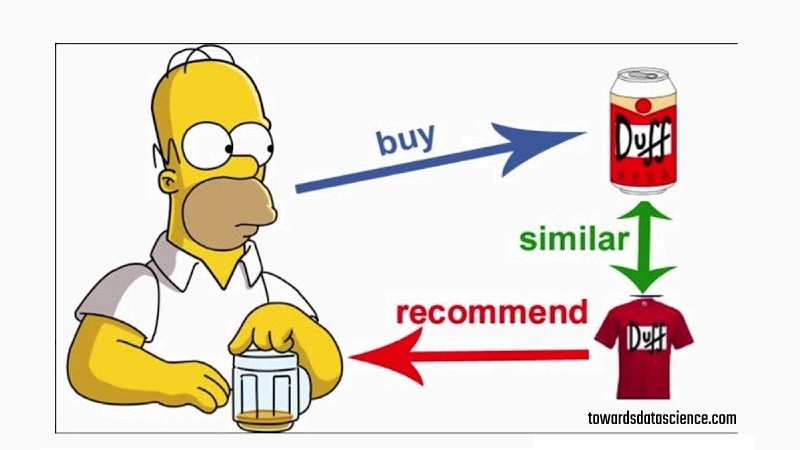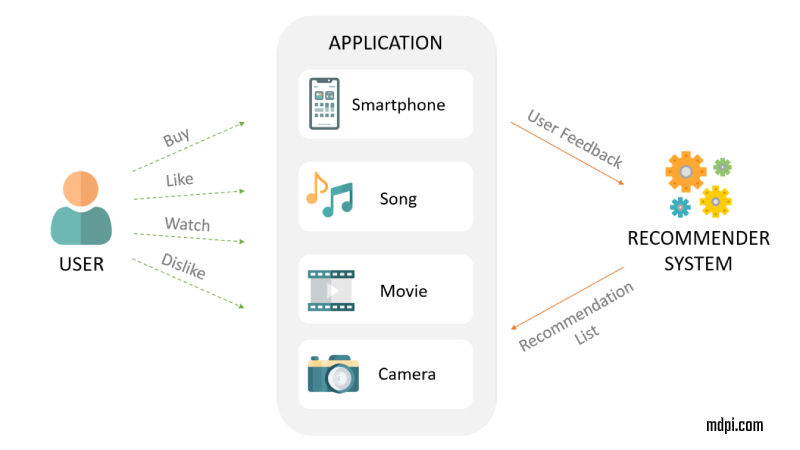
Consumers drive sales, and the most reliable method to obtain more customers is by reading their behavioral patterns. To boost sales, e-commerce gateways have turned their focus on data. This is where recommender systems arrive in handy—the system benefits websites to improve their statistics and sales figures by striving for customer fulfillment. Today, we'll understand the whole Recommendation System scene in simple language.
It predicts the user's engagements and suggests products to the users. These are pretty efficient machine learning tools that have benefited businesses to gain more profits. Recommendation systems filter user's past behavior by which it forms a structure for the user that is appropriate and added to the tags from the historic data. The machine learning algorithms foretell the items a user might like based on the past activity and generate suggestions that would have a greater possibility of the user choosing for it and the best-case scenario.

Content-based filtering process is based on previous user interest and focuses on the item that attributes to create accurate predictions. When entering a website, the site requires users to enter the age and other credentials, which help make better predictions based on user history and activity.
False Predictions by Content FilteringThis system works properly unless the data collected is falsified. In most situations, users incorrectly enter their credentials, which lead to the wrong prediction. And other factors that influence the content-based improper predictions are if new users to the platform, it does not have data that can be followed up to make recommendations because there is no data to refer it.
The factor that affects the system is that predictions are limited only with the right interest in users. It cannot suggest items with the same interest but beyond the specific category.
Content Based Filtering: How does it work?As described above, the content-based method is based on user interaction with time. In this case, the model system needs to be built along with each item. The links to each item will train the appropriate model, create recommendations based on user interest, and train the system to evolve over time and stronger.
Then train the model based on the probability of liking items by the user. This will only explain the interaction considered by the user.
This system will apply to model structures that will not be an item or user focus.

A relatively collaborative based produce more successful predictions because it is not fully based on historical data. Collaboration works with data collected from the previous item interaction, with items in the relative interest of users. This helps make Wireframe built based on past advice ideas and predict similar items. It increases customer interaction with the platform because it provides a much more personal touch with personalized recommendations.
Further filtration processes are broken down into two sub-categories
Types of Collaborative FilteringBefore providing recommendations, the system needs to have time to collect data that can be followed up. The same applies to situations where new customers on the website. This will require a lot of time to understand user behavior. This phenomenon is symbolized as a cold initial problem. These factors, until fulfilled, can falsify the accuracy of collaborative systems.
Collaborative Filtering: How does it work?There are two main methods for executing collaborative methods: neural networks that are fully connected and item2vec.
 Recommendation Systems: Backbone of eCommerce Sites
Recommendation Systems: Backbone of eCommerce Sites
Recommender systems have been proved helpful to both the product sellers and the buyers, as they decrease the excess costs for obtaining the most likely items to sell. And for the user, as the suggestions are based on likes and interests, it advances in improving the decision-making method.
The system is purely functional based on data; the data is taken from all the websites and applications that include users’ age, history, likes, reviews and much more. These form a basis to develop a recommendation that will relate to the user's persona.
These are categorized under two sections User-item interaction and Characteristic Information.
Example: For new e-commerce websites, it takes time for users to get acquainted with the user interface. In that period, the system will analyze items that have the most interaction with each user.
Recommendation System: ExamplesThe recommendation system is quite important for large-scale companies, whether it serves to increase user involvement or increase the customer frequency of visiting their market, making it an active user. This is the most bankable source & if there is data, someone needs to store data to benefit from the recommendation system effectively. This will help grow the business and generate more income after the user base grows exponentially. And this system will help the business get there. This will be proven to be one of the important systems needed to ensure growth and stability in business in the coming years.
Latest Updates from around the world
Most read stories, topics, and videos
Latest Updates from around the world